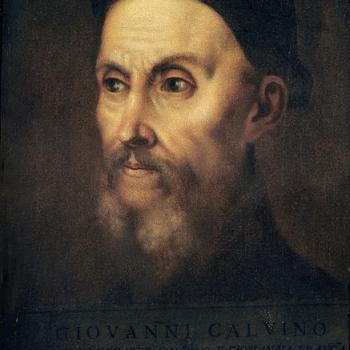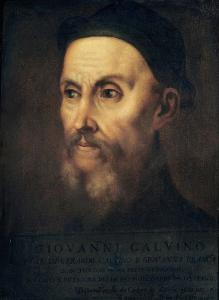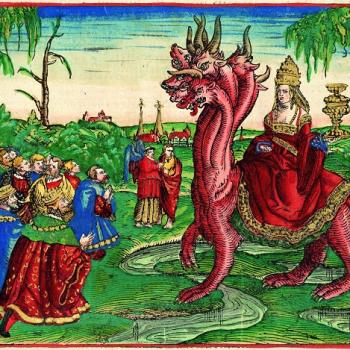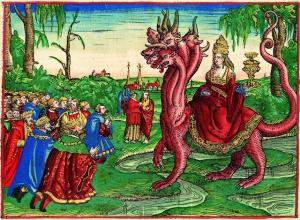Sin & God’s Providence; Does God Cause Infirmities & Send “Evil Spirits”?; Examples of God’s Immediate Judgment, Including Absalom; “A Lying Spirit”
The late Steve Hays (1959-2020) was a Calvinist (and anti-Catholic) apologist, who was very active on his blog, called Triablogue . His 819-page self-published book, Biblical Calvinism has graciously been made available for free. On 9 September 2006, Hays was extraordinarily charitable towards me (seeing that almost all anti-Catholics have treated me like Vlad the Impaler). He wrote then:
I don’t think I’ve ever accused him of being a traitor or apostate or infidel. . . . I have nothing to say, one way or the other, regarding his state of grace. But his sincerity is unquestionable. I also don’t dislike him. . . . I don’t think there’s anything malicious about Armstrong—unlike some people who come to mind. In addition, I don’t think I’ve ever said he was unintelligent. For the record, it’s obvious that Armstrong has a quick, nimble mind.
Sadly, two-and-a-half years later, starting in April 2009 and up through December 2011 (in the following quotations) his opinion radically changed, and he claimed that I have “an evil character,” am “actually evil,” an “ego-maniac, narcissist,” “idolater,” “self-idolater,” “hack who pretends to be a professional apologist,” given to “chicanery,” one who doesn’t “do any real research,” “a stalwart enemy of the faith . . . no better than [the atheists] Richard Dawkins or Christopher Hitchens,” with an intent to “destroy faith in God’s word,” “schizophrenic,” “emotionally unhinged,” one who “doesn’t trust in the merit of Christ alone for salvation,” “has no peace of mind,” “a bipolar solipsist,” “split-personality,” and a “bad” man. See more gory details.
I feel no need whatsoever to reciprocate these silly and sinful insults. I just wanted the record to be known, and to show how apologetics can too often descend to such atrocious “soul-reading” ad hominem inanities. Hopefully, Hays took to heart his own criticism of some Arminians, from this book (p. 54): “They are so caught up in the momentum of the debate that they issue intemperate threats which, after a cooling off period, they’d realize are foolhardy.” I hope and pray so.
For my part, I’ve always maintained that Hays was a very intelligent, sincere, and well-meaning man, and I believe that I can and have learned a great deal from Reformed Protestants: my brethren in Christ. We have a lot in common, but we also have honest disagreements, and this series will mostly be concerned with those. They can be discussed without acrimony or disrespect. This is one of many planned critiques of Hays’ book. I will be focusing solely on Section II: “Exegetical Considerations”. It runs from pages 20 to 186. See also the 29 installments of my Reply to Hays’ “Catholicism” series: listed on my Anti-Catholicism web page, under “Steve Hays”. My Bible citations are from the RSV. Steve Hays’ words will be in blue. Unlike the previous series, I won’t list his subtitles.
Related Reading:
Calvinism & General Protestantism: Catholic Critique web page (where all of these replies will be listed: search “Hays'”)
John Calvin: Catholic Appraisal web page
A Biblical Critique of Calvinism (book: 2012, 178 pages; includes replies to exegetical arguments in Books I-III of John Calvin’s Institutes of the Christian Religion)
Biblical Catholic Answers for John Calvin (book: 2010, 388 pages; includes line-by-line replies to Book IV of John Calvin’s Institutes of the Christian Religion)
Biblical Catholic Salvation: “Faith Working Through Love” (book: 2010, 187 pages; includes 71 pages of rebuttals of four of the five Calvinist distinctives in “TULIP”; minus the “U”)
64 Critiques of John Calvin: Introduction & Master List (more in-depth replies than what was eventually compiled in my book about John Calvin. Most were completed for his 500th birthday in 2009)
Salvation, Justification, & “Faith Alone” web page (contains many articles relevant to Calvinist soteriology and “TULIP”)
*****
[pp. 21-53 consists of Bible passages thought to be in favor of Calvinism, and quotes from commentators, with no input from Hays. I won’t interact with the commentators, because I’m answering Steve Hays, not them, but I’ll deal with a number of the Bible passages if I feel that I have a solid response. He never states what Bible version he cites from. I will cite the Bible passages as he presents them, in blue font. I have removed his bolding, but retained it for the Bible verse listing, and removed the abbreviated book names]
Genesis 45:5-8; 50:20 And now do not be distressed or angry with yourselves because you sold me here, for God sent me before you to preserve life. 6 For the famine has been in the land these two years, and there are yet five years in which there will be neither plowing nor harvest. 7 And God sent me before you to preserve for you a remnant on earth, and to keep alive for you many survivors. 8 So it was not you who sent me here, but God. He has made me a father to Pharaoh, and lord of all his house and ruler over all the land of Egypt.
20 As for you, you meant evil against me, but God meant it for good, to bring it about that many people should be kept alive, as they are today. [pp. 21-22]
Yes, of course God uses instances of human sin and brings good from them (even in the crucifixion), according to Romans 8:28 (my favorite verse): “We know that in everything God works for good with those who love him, who are called according to his purpose.” In doing so, He doesn’t wipe out human free will choices, but rather incorporates them into a larger divine plan. In other words (as Hays seems to be arguing [?]), He doesn’t foreordain or predestine sinful acts in terms of making it so that the people didn’t truly choose and simply acted like programmed robots doing God’s supposed will for sin. God doesn’t will sin.
If the point is simply noting God’s providence, no one disagrees with Calvinists as far as that goes. Calvinists so often wrongly think that non-Calvinist [serious, non-liberal) Christians disagree, but we don’t. Joseph’s brothers sold him into slavery of their own free will. God used that sin to bring good (even to the very people who committed the serious sin), and so Joseph expresses God’s providence and His working around human sin with the usual Hebrew directness and deep awareness of God’s overriding supervision: “it was not you who sent me here, but God” (Gen 45:8), even though he said three verses earlier, “you sold me here” (45:5; cf. 45:4).
That might seem contradictory (who sent Joseph to Egypt?). But it’s typical Hebrew paradox, where the same thing can be said to be done by both man and God. The brothers “sold” Joseph into slavery, and at the same time God “sent” him to Egypt. It’s the same sort of paradox that we see in Paul: “I worked harder than any of them, though it was not I, but the grace of God which is with me” (1 Cor 15:10). Calvinists don’t resonate very well with biblical / Hebraic paradox. They are very “either/or” / false dichotomy sorts of folks. I will, no doubt, repeatedly point this out in the course of this series, because it’s a serious weakness of the Calvinist position.
Exodus 4:11 Then the Lord said to him, “Who has made man’s mouth? Who makes him mute, or deaf, or seeing, or blind? Is it not I, the Lord? [p. 22]
An article on a site called Re/Knew (probably Protestant), entitled, “How do you respond to Exodus 4:11?” has an excellent explanation for this verse:
[A]s a matter of hermeneutical principle, Christians should always interpret the Old Testament in the light of the New Testament, not vice versa. . . . Throughout his ministry Jesus came against all infirmities and diseases as things that God does not will. Never once did he ascribe these things to his Father’s will. Never once did he encourage people to find comfort in the notion that these things were part of God’s plan. Rather, infirmities and diseases were consistently understood to be the result of Satan’s activity, which is why he and his disciples delivered people from them. However we interpret this Exodus passage, it must not contradict Jesus’ teaching or his example. . . .
It’s also important to note that God speaks of the human condition in general terms in this verse. As Terrence Fretheim observes, the passage does not imply that God picks and chooses which individuals will be deaf, mute or blind, “as if God entered into the womb of every pregnant woman and determined whether and how a child would have disabilities.” It only implies that God created the kind of world where mortals may become disabled. God created a risky world in which natural processes can be corrupted by free agents with the result that mortals are sometimes “flogged” . . . with infirmities like deafness and muteness. God wanted Moses to know that as the Creator he is able to work around such obstacles in achieving his objectives. In the warfare ministry of Jesus, God went further and demonstrated that the presence of his Kingdom is evidenced by overcoming such obstacles altogether.
I would add that in the book of Job it specifically states that Satan afflicted Job, with God’s permission: “And the LORD said to Satan, ‘Behold, all that he has is in your power . . . ‘ ” (1:12; cf. 2:6); “So Satan went forth from the presence of the LORD, and afflicted Job with loathsome sores from the sole of his foot to the crown of his head” (2:7). Job 42:11 refers to “all the evil that the LORD had brought upon him” but it is referring to God’s allowing of the “evil” in His providence and for His higher purpose: as seen in Job 1:12 and 2:6. All of these relevant passages have to be harmonized, rather than one perspective being ignored, with the result being that a half-truth is promulgated. God allowed the affliction of Job. brought about by the devil himself, in order to provide this story in the Bible, that has comforted many millions of people. He brought good out of it, just as He did in Joseph’s case.
Likewise, when Jesus met the woman “who had had a spirit of infirmity for eighteen years; she was bent over and could not fully straighten herself” (Lk 13:11), He didn’t say that God had caused this, let alone ordained it from all eternity. Rather, He stated, “ought not this woman, a daughter of Abraham whom Satan bound for eighteen years, be loosed from this bond . . .?” (13:16). Not only did He deny that God caused the infirmity, but directly attributed it to Satan’s wicked opposition. Peter stated the same sort of thing: “Jesus of Nazareth . . . went about doing good and healing all that were oppressed by the devil” (Acts 10:38).
Moreover, Paul notes that “a thorn was given me in the flesh.” This appears to be another bodily infirmity (many scholars think it may have been a disease of the eyes). How does he characterize it?: as a “messenger of Satan” (2 Cor 12:7). So that’s at least four times that the Bible attributes physical ailments to the devil as the cause and continued persecutor, and not to God. What more is needed to disprove the contrary? God will use the illnesses and ailments and bring good from them, but He didn’t cause or ordain them.
Judges 9:23 And God sent an evil spirit between Abimelech and the leaders of Shechem, and the leaders of Shechem dealt treacherously with Abimelech [p. 24]
This is the same dynamic as in the book of Job: Satan caused the “evil spirit” and God allowed it in His permissive will. Many Protestant commentaries concur:
Benson Commentary: God sent an evil spirit — That is, gave Satan permission to work upon their minds. . . . God can, with the greatest ease, make all the devices of the wicked of none effect; can turn their best contrivances to their ruin . . .*Matthew Poole’s Commentary: God gave the devil commission to enter into or work upon their minds and hearts; . . .*Gill’s Exposition of the Entire Bible: Then God sent an evil spirit between Abimelech and the men of Shechem,…. Permitted, yea, gave a commission to Satan, the evil spirit, to go among them . . .*Wesley’s Notes on the Bible: God gave the devil commission to work upon their minds.
Similarly, 1 Samuel 16:14 states that “an evil spirit from the LORD tormented” King Saul, and many commentaries (e.g., Benson, Matthew Henry, Matthew Poole, John Wesley) explain it as another instance of the same dynamic of God permitting Satan to torment Saul.
1 Samuel 2:25 If someone sins against a man, God will mediate for him, but if someone sins against the Lord, who can intercede for him?” But they would not listen to the voice of their father, for it was the will of the Lord to put them to death. [pp. 24-25]
There comes a time for judgment and divine wrath as well, and these three boys had apparently reached that point, as habitual fornicators and guilty of “evil dealings” spoken of by “all the people” (1 Sam 2:22-23). God — as our Creator — has power and the prerogative over life and death. Human beings can rebel against Him to such an extent that He at length (knowing this this from all eternity) decides that their time for judgment and damnation has arrived, after having “given them up” (Rom 1:24, 26, 28).
In the New Testament the same thing occurred with Ananias and Sapphira, who “lie[d] to the Holy Spirit” (Acts 5:3) and “tempt[ed] the Spirit of the Lord” (5:9). Both were immediately judged by God and killed (5:5, 10). Interestingly, this passage ties in with 1 Samuel 2:25 insofar as both have to do with sinning against the Lord as opposed to against men. Another example of instant judgment from God had to do with Korah’s rebellion, in the wilderness with Moses:
Numbers 16:28-35 And Moses said, “Hereby you shall know that the LORD has sent me to do all these works, and that it has not been of my own accord. [29] If these men die the common death of all men, or if they are visited by the fate of all men, then the LORD has not sent me. [30] But if the LORD creates something new, and the ground opens its mouth, and swallows them up, with all that belongs to them, and they go down alive into Sheol, then you shall know that these men have despised the LORD.” [31] And as he finished speaking all these words, the ground under them split asunder; [32] and the earth opened its mouth and swallowed them up, with their households and all the men that belonged to Korah and all their goods. [33] So they and all that belonged to them went down alive into Sheol; and the earth closed over them, and they perished from the midst of the assembly. [34] And all Israel that were round about them fled at their cry; for they said, “Lest the earth swallow us up!” [35] And fire came forth from the LORD, and consumed the two hundred and fifty men offering the incense.
God alone knows men’s hearts. He knows when they are beyond all redemption; when they have committed the unforgivable sin of blasphemy against the Holy Spirit (Mt 12:31-32; Lk 12:10), and so are ripe for just judgement. In this case, they “despised the LORD” (Ex 16:30). That’s very serious sin, as in the other cases above. In every reprobate person’s life there comes a time when God says to them, “Fool! This night your soul is required of you” (Lk 12:20).
2 Samuel 17:14 And Absalom and all the men of Israel said, “The counsel of Hushai the Archite is better than the counsel of Ahithophel.” For the Lord had ordained to defeat the good counsel of Ahithophel, so that the Lord might bring harm upon Absalom. [p. 25]
This is another case of God’s judgment of a person beyond redemption. Absalom, David’s son, had resolved to rebel against his father and become king (2 Sam 15:4, 6, 10, 12-13). It got so bad that David advised his servants to flee Jerusalem with him, fearing that Absalom would “bring down evil upon us, and smite the city with the edge of the sword” (15:14). Ahithophel became one Absalom’s “conspirators” and David prayed, “O LORD, I pray thee, turn the counsel of Ahithophel into foolishness” (15:31). Absalom was trying to murder his father David (16:11; 17:2, 4). After all that, the text states that “the LORD had ordained to defeat the good counsel of Ahithophel, so that the LORD might bring evil upon Absalom” (17:14).
Absalom met his end by getting his head stuck in the branches of an oak tree while riding a mule (18:9), and then being finished off by David’s allies (19:14-15). God can strike someone dead if He so chooses, or know that a natural calamity will bring about the same end, as in this case. Absalom sealed his fate by opposing David, the “man after [God’s] own heart” (1 Sam 13:14; cf. Acts 13:22) and the prototype of the Messiah and God the Son, Jesus.
2 Chronicles 18:19-22 And the Lord said, ‘Who will entice Ahab the king of Israel, that he may go up and fall at Ramoth-gilead?’ And one said one thing, and another said another. 20 Then a spirit came forward and stood before the Lord, saying, ‘I will entice him.’ And the Lord said to him, ‘By what means?’ 21 And he said, ‘I will go out, and will be a lying spirit in the mouth of all his prophets.’ And he said, ‘You are to entice him, and you shall succeed; go out and do so.’ 22 Now therefore behold, the Lord has put a lying spirit in the mouth of these your prophets. The Lord has declared disaster concerning you.” [p. 25]
Most people think this “spirit” is an instance of the personification of the spirit of prophecy. It’s definitely not an evil spirit. Keil and Delitzsch Biblical Commentary on the Old Testament states concerning the parallel passage in 1 Kings 22:
The spirit (הרוּח) which inspired these prophets as a lying spirit is neither Satan, nor any evil spirit whatever, but, as the definite article and the whole of the context show, the personified spirit of prophecy, which is only so far a πνεῦμα ἀκάθαρτον τῆς πλάνης (Zechariah 13:2; 1 John 4:6) and under the influence of Satan as it works as שׁקר רוּח in accordance with the will of God. . . . Jehovah sends this spirit, inasmuch as the deception of Ahab has been inflicted upon him as a judgment of God for his unbelief. But there is no statement here to the effect that this lying spirit proceeded from Satan, because the object of the prophet was simply to bring out the working of God in the deception practised upon Ahab by his prophets. . . .
Jehovah has ordained that Ahab, being led astray by a prediction of his prophets inspired by the spirit of lies, shall enter upon the war, that he may find therein the punishment of his ungodliness. As he would not listen to the word of the Lord in the mouth of His true servants, God had given him up (παρέδωκεν, Romans 1:24, Romans 1:26, Romans 1:28) in his unbelief to the working of the spirits of lying. But that this did not destroy the freedom of the human will is evident from the expression תּפתּה, “thou canst persuade him,” and still more clearly from תּוּכל גּם, “thou wilt also be able,” since they both presuppose the possibility of resistance to temptation on the part of man.
***
Practical Matters: Perhaps some of my 4,300+ free online articles (the most comprehensive “one-stop” Catholic apologetics site) or fifty-one books have helped you (by God’s grace) to decide to become Catholic or to return to the Church, or better understand some doctrines and why we believe them.
Or you may believe my work is worthy to support for the purpose of apologetics and evangelism in general. If so, please seriously consider a much-needed financial contribution. I’m always in need of more funds: especially monthly support. “The laborer is worthy of his wages” (1 Tim 5:18, NKJV). 1 December 2021 was my 20th anniversary as a full-time Catholic apologist, and February 2022 marked the 25th anniversary of my blog.
PayPal donations are the easiest: just send to my email address: [email protected]. You’ll see the term “Catholic Used Book Service”, which is my old side-business. To learn about the different methods of contributing, including 100% tax deduction, etc., see my page: About Catholic Apologist Dave Armstrong / Donation Information. Thanks a million from the bottom of my heart!
***
Photo credit: Portrait of John Calvin by Titian (1490-1576) [public domain / Wikimedia Commons]
***
Summary: This is one of my many (often point-by-point) replies to the “Exegetical Considerations” section (pp. 20-186) of Steve Hays’ “Biblical Calvinism” book.











